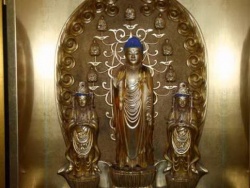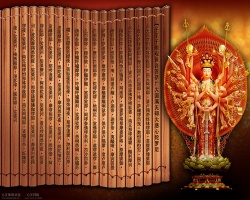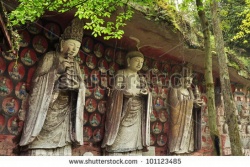Classifications of Buddha Dharma Teachings
Jump to navigation
Jump to search
- By way of very general introduction, when we speak of the Buddha Dharma we are speaking of what are traditionally said to be the 84,000 collections of teachings that the Buddha Shakyamuni transmitted in the holy country of India. To speak of these in a more concise way, we very often speak of the Three Turnings of the Wheel of Dharma, because the Buddha Shakyamuni first turned the Wheel of the Dharma of the Four Noble Truths in Varanasi, secondly Turned the Wheel of the Perfection of Transcendent Knowledge, the Prajnaparamita teachings, at Vulture Peak near Rajagrha, and thirdly Turned the Wheel of the Dharma that dealt with Definitive Ultimate Truth in a very precise way in Vaisali and other places around the northern part of the Indian sub-continent. When we speak of the scriptures associated with the Buddhist teachings, we hear reference to the Tripitaka, the three baskets or collections of the teachings, and these are the Vinaya or ethical codes, the Sutras, and the Abhidharma, or the teachings on metaphysics and psychology. In the case of the Vajrayana we have a fourth collection, that of the Tantras. This, from the general scriptural point of view, is the breadth of the Buddhist teachings that will be presented here. If we were to further classify and categorize these 84,000 collections of teachings in a concise way, we could distinguish between the Sutra approach and the Tantra approach. In the Sutra approach there are, on the one hand, the more obscure teachings, those that are not completely evident, which are presented in such a way that much of the meaning is concealed; on the other hand, there are Sutra teachings concerning emptiness, which deal quite forthrightly with the nature of reality as a state of emptiness.
- Origins of the Prajnaparamita Texts
- Teachings on emptiness are primarily derived from the middle turning of the Wheel of Dharma. It at the peak known as Vulture Peak, near Rajagrha, in India, when the Buddha was turning the Wheel of the Prajnaparamita (the "Perfection of Wisdom") that he presented the teachings dealing with emptiness. When these teachings were actually expounded by the Buddha, he taught seventeen primary and secondary Sutras of Prajnaparamita, the Perfection of Wisdom. But, on that occasion, not only were human beings present, but also present were Devas (or Gods) of Samsara, Nagas, and other powerful beings from other realms who received these teachings and took them back to their own regions, so that some of the Sutras that the Buddha presented on this occasion did not spread in the human realm, although there is a record in our literature of them having been transmitted. For example, the Sutra in 10 Million Verses was taken by the Devas to their realm, the Sutra in 2 Million Verses was taken to the realm of the Gandarvas, and the Sutra in 100-Thousand verses was taken to the realm of the Nagas. When we speak of these Sutras being taken, it simply indicates that these beings had total recall. It was as though they made a tape recording of the Buddha speaking. They could simply go back to their realms with all of the teachings that the Buddha had given in their memories. It's not as though a book was there and was taken, but that the teachings themselves, as they were given, were completely remembered by these beings when they returned to their realms. However, these teachings did not spread in the human realm on that occasion.
- Nagarjuna
- In the teachings of the Mahayana tradition of Buddhism, there is an account of the Buddha, before he passed into Nirvana, issuing a prophecy that some years following his passing into Nirvana there would appear an extraordinary teacher who would bear the name of the Nagas in his name, and who would re-vivify the teachings of the Prajnaparamita, establish the unsurpassable view of the Perfection of Wisdom, and thus establish circumstances for enormous benefit to the teachings and to beings. This is widely held to be a prophecy of the coming of Nagarjuna, the great Buddhist master who did so much too further spread the teachings of the Prajnaparamita. Following the passing of the Buddha into Nirvana, the early history of Buddhism in India was based upon the teachings of the Hinayana, so the earliest schools of Buddhist philosophy and practice in India were Hinayana schools. At that point, the Mahayana did not exist as its own tradition in India. But at a certain point, more than a hundred years after the passing of the Buddha into Nirvana, there appeared in the south of India an individual who grew up to become the great master Nagarjuna. This is not to say that the Mahayana teachings were extinct or absent before this, but there was not an integrated tradition of what we would call Mahayana Buddhism. When Nagarjuna grew up and began to study the Dharma, he was fortunate to come into contact with such great masters as the Siddha Saraha, who introduced him to the teachings of the Mahayana. Through his practice, Nagarjuna achieved a state of deathlessness. His name Nagarjuna means "one who has conquered, tamed, and gained mastery over the Nagas". So one aspect of his spiritual attainment was his ability to control the Naga spirits. Because of his mastery over these Naga spirits, Nagarjuna was invited by the Nagas to visit their realm. Knowing through his spiritual practice that the Sutra in 100 Thousand Verses was present in their realm, Nagarjuna made the journey. His specific purpose in journeying to that realm was to recover the Sutra in 100,000 Verses, because he realized that the absence of this Sutra in the human realm was a great loss. When Nagarjuna was preparing to return from the Naga to the human realm, the Naga spirits offered him great wealth, the Nagas being extraordinarily wealthy, but Nagarjuna refused all of their offers of material wealth. He said that the only suitable offering was the Sutra in 100,000 Verses. So the Sutra was offered to him, and he returned to the human realm with this teaching. But when the Sutra was offered to Nagarjuna, it was offered in an incomplete version. The Nagas offered him twelve volumes containing the bulk of the Sutra in 100,000 Verses, but they held back a portion of the text because they were afraid that, if they gave Nagarjuna the entire text, he'd never return to the Naga realm. So what came back to the human realm was in fact an incomplete version. The original text that Nagarjuna brought back from the Naga realm was written in Sanskrit, which is considered to be the language of the Gods, the language of the Devas. �There are extant manuscripts of this Sutra in 100,000 Verses. In one of the libraries in Nepal, for example, there is a manuscript of this text in Sanskrit.
- The Mulamadhyamakakarika
- When Nagarjuna brought this text back to the human realm, he realized that the volume of the material was so great that people would not be able to absorb all of it because they had short lives, little merit, and very little time to study. So he composed his famous commentaries which are more concise and were based upon the Prajnaparamita. Perhaps the most famous of these is the Mulamadhyamakakarika, "Root Verses on the Middle Way Philosophy", which is one of six major commentaries written by Nagarjuna, each of which was famous for its concise presentation of the view of the Madyamika or "Middle Way" philosophy that emptiness is the true nature of reality.
- Aryadeva
- Nagarjuna also trained students who carried on his tradition of teaching by writing commentaries on their master's original commentaries. Aryadeva, who was the student of Nagarjuna who wrote most upon the subject of meditation, wrote a text called the Catuhsataka or the "400 Verses", which is a direct commentary on the "Root Verses of the Middle Way" that Nagarjuna wrote. In the presentation of emptiness in Aryadeva's text, the Catuhsataka or the "400 Verses", the emphasis is on meditation upon emptiness, upon the direct experience of emptiness through practice.
- Shantideva
- Among those who followed the tradition of Nagarjuna were those who commented primarily upon conduct, upon how the Bodhisattva conducts him or herself in the pursuit of enlightenment. Perhaps the most famous student of this type was the great Shantideva, who lived and taught at the monastery and the University of Nalanda, and whose life was marked by seven utterly miraculous events. The most famous text that Shantideva wrote is the Bodhicharyavatara "The Entry into The Path of the Bodhisattva" or "Entry into The Conduct of the Bodhisattva. The primary emphasis in Shantideva's text is upon conduct, upon what kind of ethical choices the Bodhisattva should make: what to avoid and what to encourage in his or her actions.
- Chandrakirti
- It was a student of a student of Nagarjuna's, the great master Chandrakirti, who wrote a text called the Madyamikavattara, "The Entrance Into the Middle Way", which is held to be perhaps the finest example of a text that comments upon view, meditation, and conduct simultaneously, without emphasizing any one of these. In all of Chandrakirti's discussions there is a very analysis of the different paths of the Mahayana, the Five Paths of the Mahayana and the ten levels of Bodhisattva realization, the Ten Bhumi.
- Shantarakshita
- Yet another master in the tradition of Nagarjuna was Shantarakshita who wrote a text called the Umagen (Sanskrit Madhyamakalankarakarika), "The Ornament of The Middle Way", which concisely details the teachings on view, meditation, and conduct from the point of view of the understanding and direct experience of emptiness.
- Transmission to Tibet
- These are the teachers and commentaries that are derived from the Indian tradition of Buddhism, from the original tradition as it developed in India. These commentaries were translated from the original Indian languages into Tibetan and form part of the large collection known as the Tanjur, which contains more than 200 volumes. In fact, the number of Indian commentaries extant in Tibetan translation represent perhaps 25% of what was available in Buddhist India. There was such a wealth of material that not all of it could be translated. The particular text that I will be teaching is written by a Tibetan; however, it is a text by a great master of the Tibetan tradition of Buddhism. There is no comparable collection to the Tanjur for the Tibetan commentaries. Any collection that might be attempted would be much larger than the Tanjur. The Tibetans were so prolific in writing commentaries on the subjects contained within the Tanjur that nobody has ever attempted to put every writing from the Tibetan traditions together in a single collection.
- The Four Main Indian Buddhist Schools
- In the development of Buddhist philosophy in India, four major schools of philosophy historically have come to be recognized. The first of these is known as the Vaibashika school, which literally means "the analyst", those who analyze things in detail. The second is known as the Sautantrika, which means "those who follow the Sutras". The third is the Cittamatra, or Yogacara school, which literally means the "mind-only" school. And the fourth is the Madhayamika or "Middle Way" school of philosophy. When you hear discussions of Buddhist philosophical schools, these four tend to be mentioned.
- The Four Main Tibetan Buddhist Schools
- In the case of the Tibetan tradition of Buddhism, the earliest school of thought established in Tibet is the one that we know as the Nyingma, "the early translation" or "ancient school". Then, in chronological order, the Sakya school, the Kagyu school, and the Gelugpa school developed. Again, if we were to try to count, or assess, the number of commentaries written by the masters of these four schools of Tibetan Buddhism on Madhayamika, on emptiness, all we can say is that there are a lot. Nobody's ever sat down and actually figured out how many, but there are an enormous number of commentaries. In ratio to the amount of commentary about the Middle Way philosophy of emptiness, there was a profusion of controversy among the various schools of thought as to who had the right view, who had the correct interpretation, and so-forth. There has been quite a history of spirited controversy and debate in Tibet




